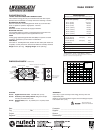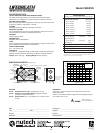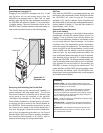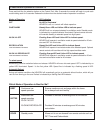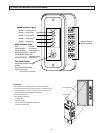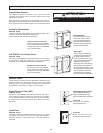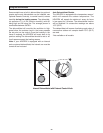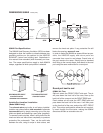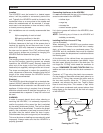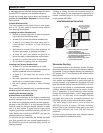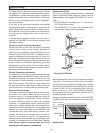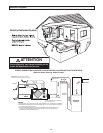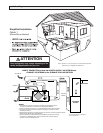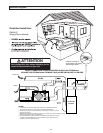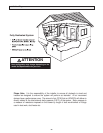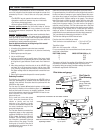
22
Location
The HRV/ERV must be located in a heated space
where it will be possible to conveniently service the
unit. Typically the HRV/ERV would be located in the
mechanical room or an area close to the outside wall
where the weatherhoods will be mounted. If a base-
ment area is not convenient or does not exist, a utility
or laundry room may be used.
Attic installations are not normally recommended due
to:
A) the complexity of work to install
B) freezing conditions in the attic
C) difficulty of access for service and cleaning
Sufficient clearance at the front of the access door is
required for servicing the air filters and core. A mini-
mum of 25" (635 mm) clearance is recommended so
the door can be opened. Four PVC reinforced poly-
ester hanging straps are provided for hanging the
HRV/ERV from the basement floor joists.
Mounting
The hanging straps should be attached to the unit at
the top end corners (mounting screws are already
located on the HRV/ERV case). Securely fasten the
other end of the straps to the floor joists with wide
head nails (not supplied), making sure the unit is level.
The straps are designed to reduce the possibility of
noise, resonance or harmonics; therefore using the full
length of the strap between the HRV/ERV and the
floor joists is recommended.
Electrical
The HRV/ERV should be plugged into a standard des-
ignated (120VAC) electrical outlet with ground. It is not
recommended that an extension cord be used for this
appliance. If further wiring is required, then a licensed
electrician should make all electrical connections. It is
recommended that a separate 15 amp/120 volt circuit
be used.
WARNING:
In order to prevent electric shock when cleaning or
servicing the HRV/ERV, it is extremely important to
confirm the polarity of the power line that is switched
by the safety (disconnect) switch. The hot line (black)
is the proper line to be switched. To confirm the proper
polarity, use a voltmeter or test lamp to ensure there is
no power after the switch when the door is open.
Check between that point and ground (on the cabinet).
This must be done as dwellings are occasionally wired
improperly. Always make sure that the HRV/ERV is
properly grounded.
Connecting Appliances to the HRV/ERV
It is not recommended that any of the following appli-
ances be connected to the HRV/ERV:
• clothes dryer
• range top
• stovetop fan
• central vacuum system
Lint, dust or grease will collect in the HRV/ERV, dam-
aging the unit.
NOTE:
Connecting any of these to the HRV/ERV will
invalidate your warranty.
Installing the Drain Line and P-Trap
(not on all models)
When defrosting, the HRV/ERV may produce some
condensation. This water should flow into a nearby
drain, or be taken away by a condensate pump. The
HRV/ERV and all condensate lines must be installed
in a space where the temperature is maintained above
the freezing point.
At the bottom of the cabinet there are prepunched
hole for the drain pan connectors (see below). Insert
the drain spout through the hole in the drain pan. Do
not forget the “O Ring” which seals the connector to
the pan. REMEMBER TO HAND TIGHTEN ONLY the
washer and lock nut which hold the drain connector in
place.
Construct a P-Trap using the plastic tee connector.
Cut two lengths of hose and connect each piece to an
end of the “T” fitting, then connect the other ends to
the two drain spouts. Allow the "T" fitting to point
upwards, and connect the drain line. Tape or fasten
base to avoid any kinks. This creates a “trap” which
will hold some condensate and prevent odours from
being drawn up the hose and into the fresh air supply
of the HRV/ERV.
DRAIN
SPOUT
TAPE
TO DRAIN
TEE
CONNECTOR
DRAIN
SPOUT
PRE-PUNCHED HOLES (2)
DRAIN PAN DRAIN PAN
Forming the "P" Trap
Installation



